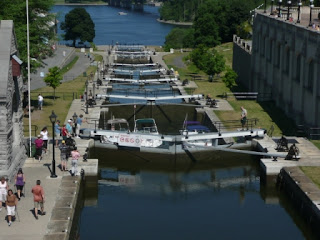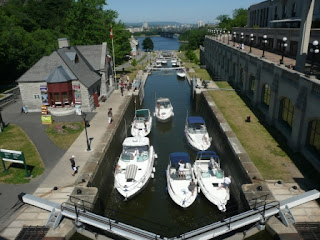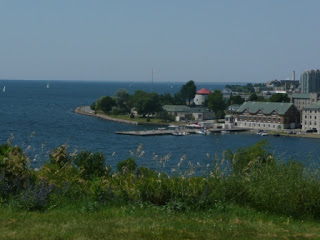We've made it up the Rideau Canal to Ottawa. I'm sorry not to have posted during the trip but we are on very limited bandwidth rations up here and I can only post when we are in a marina that offers WiFi with its dockage. Our Verizon Canada data plan just barely gives us enough bandwidth to pick up and respond to email.
 |
| Water boils in as the lock fills |
We have now made it through nearly half of our 99 locks. This is a picture of what a lock looks like when you are going up in the lock. You can see the water boiling in from the bottom of the lock. That water will fill the lock, then the gates will open and let the boats move through.
 |
| Exiting after going down |
This picture is of a boat that has gone down in a lock and is getting ready to leave the lock. You can see the wet wall of the lock next to the boat; in this case the lock probably lowered the boat 8-10 feet. With only one exception, most of the Rideau Canal locks don't raise or lower a boat more than 8-10 feet because these locks were all built using hand tools 180 years ago, making them larger wasn't really an option. but there are places where the water levels change more than 8-10 feet. To accommodate the larger changes, the lock builders built "flights" of locks, or a series of locks attached to each other.
 |
| Ottawa flight |
The longest flight is here in Ottawa. There are eight locks in succession. It can take was long as 2 1/2 hours to transit from one end to the other.
 |
| Packing in the boats |
One of the legendary seasons of summer in this part of Canada is known as the invasion of the French Canadian navy. The building trades in Quebec all take the same two weeks off every summer. And many other Quebecois take the same time off. Apparently many Quebecois have boats and they all like to visit either the 1000 Islands or the Rideau Canal. Non-Quebecois transients are warned that the Canal gets very congested during this two week period. We got our first taste of what this means yesterday, the first Saturday of the holiday. the first locking through at the Ottawa flight Saturday found 13 boats waiting to come up into the city. There were so many waiting, the Parks staff actually had some boats tying off to each other in the lock because there wasn't enough wall space for each boat to tie to the wall. They also filled three of the eight locks in the flight in a single transit. That all meant that the boats waiting to go down had a nearly four hour wait for the upcoming boats to clear the lock.
This morning there were only eight boats waiting, but that still required filling two of the locks and a wait of nearly three hours for the down-bound boats. We asked the Parks staff if they think it will be as busy on Monday, but they can't predict. Fortunately, we've planned for this. We're only going across the Ottawa River to Hull tomorrow. It won't take us more than a hour once we clear the locks, so if we have to wait until 11:00 AM to go and it takes us 2 hours to get through, we'll still get where we're going by mid-afternoon.
 |
| Docking the plane |
Not eveyone who lives on the Rideau Canal gets to their home by boat. We saw several houses where the boat was sharing dock space with the plane.
 |
| Mountie band |
We've enjoyed Ottawa. The Mounties do a changing of the guard ceremony at the Parliament building every morning. The RCMP band and the incoming guard unit march from their barracks to Parliament Hill every morning at 9:45 AM. The barracks is directly across the Canal from where we are docked, so we went over one morning and walked through downtown Ottawa with them. You've got to understand, in the time we've been here Ottawa has set an all time record for heat (heat index of 46 degrees Centigrade or 115 Farenheit). these guys (and gals) are wearing wool uniforms and bear skin hats. It was only a 15 minute walk through town, but it was then followed by a 30 minute ceremony on the Parliament grounds. It was a wonder someone didn't pass out from the heat.
 |
| Canada's Parliament buildings |
 |
| Clock tower gargoyles |
Parliament is a typical old mid-18th century Victorian set of buildings. The coolest feature is the great gargoyles on the clock tower, during the day time. But at night the city does a free light and sound laser show of the history of Canada, projected on the Parliament buildings. It is an amazing event. They light the building with colors. They use it as a canvas to show projections of waterfalls, beavers building dams, moose and elk wandering in the mountains, Canada geese flying. They even project some snippets of TV shows on the building. The show covers Canadian history from the first people (natives) to the modern day.
Ottawa also has the oldest outdoor market in Canada. It has been operating since the 1840s. And, since the entire city was built around the canal, the market is convenient for boat re-provisioning. So, fully stocked, we'll take our chances with the flight tomorrow morning, then on to Montreal. We'll post again when bandwidth is available.






















